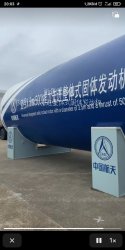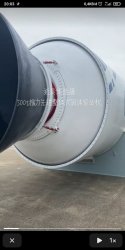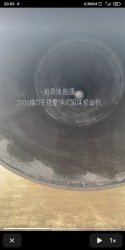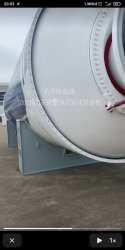You are using an out of date browser. It may not display this or other websites correctly.
You should upgrade or use an alternative browser.
You should upgrade or use an alternative browser.
China's Space Program Thread II
- Thread starter Blitzo
- Start date
lcloo
Major
500 tons solid fuel rocket.
500 tons of thrust, the most powerful one piece solid fuel rocket booster on the planet, first successfully test fired late last year:500 tons solid fuel rocket.
Carbon fiber casing too so dry mass would be low compared to steel cased rocket.
3.5m diameter is even wider than the DF-4. Given that solid propellant is a lot more dense than liquid fuel like the one used in the DF-4 this solid is totally overkill. Is this for a lunar rocket or what?
For reference the Shuttle Solid Rocket Booster has 3.7m diameter and the Ariane 5 P230 solids have 3m diameter.
For reference the Shuttle Solid Rocket Booster has 3.7m diameter and the Ariane 5 P230 solids have 3m diameter.
500 tons of thrust, the most powerful one piece solid fuel rocket booster on the planet, first successfully test fired late last year:
Carbon fiber casing too so dry mass would be low compared to steel cased rocket.
3.5m diameter is even wider than the DF-4. Given that solid propellant is a lot more dense than liquid fuel like the one used in the DF-4 this solid is totally overkill. Is this for a lunar rocket or what?
For reference the Shuttle Solid Rocket Booster has 3.7m diameter and the Ariane 5 P230 solids have 3m diameter.
1000t is under-development.
Maybe the spare space station core module could be used in Lunar orbit?
Along with 2 more labs mainly dedicated to Lunar science and Human life support, this could be done immediately without waiting for the base to be built.
The best thing is that this model can be applied to any planetary body.
Along with 2 more labs mainly dedicated to Lunar science and Human life support, this could be done immediately without waiting for the base to be built.
The best thing is that this model can be applied to any planetary body.
I'm a bit confused because there must be a metric that I must've missed.
Unless they're talking about a segmented config (which would make sense since the SRB above is only 150t in mass) for total combined thrust with each segment capable of supplying 500t in thrust, how is 500t the biggest SRB?
The SLS' 5-segment SSSRB each already outputs over 1,800t (16,000kN). The Ariane 5's current P241 SRB has almost 800t (7,000kN) each as well.
So if anything the 1,000t class would be a meaningful achievement, but that would still trail behind the SSSRB, no?
Unless they're talking about a segmented config (which would make sense since the SRB above is only 150t in mass) for total combined thrust with each segment capable of supplying 500t in thrust, how is 500t the biggest SRB?
The SLS' 5-segment SSSRB each already outputs over 1,800t (16,000kN). The Ariane 5's current P241 SRB has almost 800t (7,000kN) each as well.
So if anything the 1,000t class would be a meaningful achievement, but that would still trail behind the SSSRB, no?
Solid rockets burn the fuel from the center to the edges of the cylinder. So the longer the rocket the more thrust it will have.
This is supposedly the largest and most powerful single piece solid.
The Shuttle Solid Rocket Boosters and the Ariane 5 P230 are segmented solids. Not single piece.
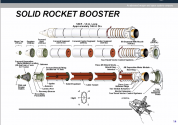
This is supposedly the largest and most powerful single piece solid.
The Shuttle Solid Rocket Boosters and the Ariane 5 P230 are segmented solids. Not single piece.

Last edited:
Yeah I know, so it's most likely to be segmented like I said, in which case 500 tonnes-force per 150t in fuel mass would be a big deal, but not so much if it's the whole booster.Solid rockets burn the fuel from the center to the edges of the cylinder. So the longer the rocket the more thrust it will have.
In comparison if we divide up the SLS's SSSRB's max thrust of 1,800t per 730t mass, that works out roughly at around 360t in thrust for each segment of five.
The first launch was to test the structure, the interior was incomplete, things that are not needed for the flight are not there such as life support system, some electronics only meant for crew operation etc.Any Info about the purpose of the launch?
The coming launch would be very close to the final state except crew which will be dummies with sensors.
CZ-5B can not launch it to the moon.Nasa is launching Orion around the moon while I don't think Long March 5B can launch NGCS to the moon.
The state of the craft would be significantly different inside, but the flight profile would be similar or identical to the first launch. The mission is different.Are they going to repeat the the previous mission? testing long endurance flight?
No, the orbit would be very high (around 8000km)or even test docking with Tianggong?
It is worth to note that Orion's first launch was less complete than CNSA's first launch. It did not have its service module but a dummy with real jettison mechanics but no motor and fuel to test multiple restart and acceleration/deceleration. CNSA's first launch was a working service module. CNSA has simulated the deceleration for moon orbit capture, and acceleration for earth returning journey. Orion did not test any of them.
The coming Orion launch around the moon is to do these missing tests. NASA's approach to the first launch was due to the fact that the service module was far behind the crew module in progress. Taking Orion around the moon in the coming launch is not technically necessary for Orion itself but a combined test for SLS's maiden flight since SLS's full stack is meant for the moon, so why not do it together.

